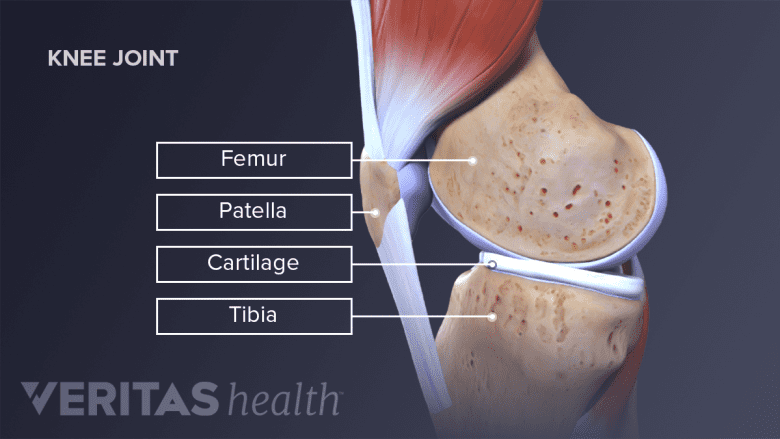The knee is the largest joint in the human body and a common source of athletic-related injuries. Classified as a pivotal hinge joint, the knee allows for straightening and bending in one direction, with some twisting (screw home mechanism).
The knee joint is made up of bones, cartilage, ligaments, tendons, bursae, and meniscus. A injury to any one of these structures can cause knee pain.

The knee joint is comprised of 3 bones: the kneecap (patella), the thigh bone (femur), and the shin bone (tibia).
In This Article:
- Guide to Knee Joint Anatomy
- Soft Tissue of the Knee Joint
- How Knee Joint Problems Cause Pain
Musculoskeletal Structures
Bones of the knee joint
The knee joint is comprised of three bones that interact to allow for hinge-like motion:
- The tibia (shin bone). The tibia is the primary weight bearing bone of the lower leg and connects to the bottom of the femur, forming the hinge of the knee joint.
- The femur (thigh bone). The femur is both the longest and strongest bone in the human body. It supports the upper body weight during standing, walking, or running. Injuries to the femur can take longer to heal than injuries to other bones. The femur is covered in cartilage where it meets with the tibia (below the femur) and patella (front of the femur).
- The patella (kneecap). The patella sits at the anterior-most (front) of the knee joint. The patella anatomically lies in the front of the knee, in the groove formed by the two cartilage covered expansions (condyles) of the lower femur (patellofemoral joint).
See Symptoms of Kneecap Dislocation and About Acute Patellar Injuries
In a healthy knee, the back of the kneecap and femur are covered in articular cartilage, allowing the two bones to move against one another without friction or pain.
Muscles of the knee joint

The quadricep and hamstring group of muscles work together to support and move the knee joint.
The quadriceps muscles and hamstring muscles provide most of the power and control for the knee joint.
- The quadriceps muscles. This is a group of four muscles: (vastus lateralis, vastus intermedius, vastus medialis, and rectus femoris) located on the front of the thigh. These muscles are connected to the knee joint via the quadriceps tendon. When these muscles contract and shorten, the leg is straightened.
- The hamstring muscles. This is a group of 3 muscles (biceps femoris, semimembranosus, and semitendinosis) located on the back of the thigh and knee joint. When activated these muscles act to bend the knee.
Both muscle groups are vital to forward motion. Injuries to these muscle groups can range from mild strains and bruises to debilitating tears.

